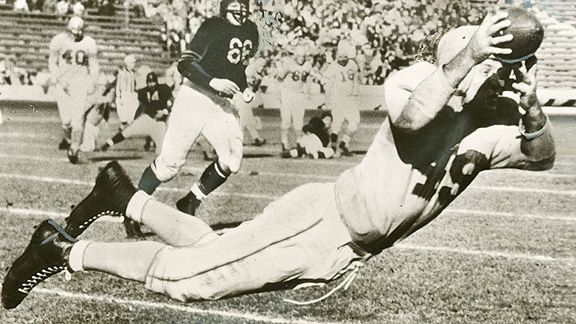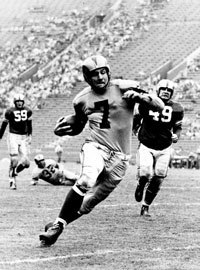 Ever heard of Jim Benton? Don’t worry; most football fans haven’t. Yet the Cleveland/Los Angeles Rams star of the 1930s and 1940s still ranks #4 all time in most receiving yards in a single game.
Ever heard of Jim Benton? Don’t worry; most football fans haven’t. Yet the Cleveland/Los Angeles Rams star of the 1930s and 1940s still ranks #4 all time in most receiving yards in a single game.
On this day 97 years ago—August 20, 1920—the National Football League was founded in that legendary Hupmobile dealership in Canton, Ohio.
In 1965, the very last NFL season that would not end with the playing of a spectacular called the Super Bowl was completed.
Between those two events lie the approximate number of seasons—45—that have gone down the memory hole of NFL history.
Why?
If the NFL encompassed the entire universe—and sometimes it seems to think it does—the Big Bang would have occurred in 1958 with the TV sensation called the “greatest game ever played.”
But the present-day NFL emerged from stardust in 1967 when the Super Bowl was born. Prior to that, pro football was . . . misty and mostly unknowable. Primitive, prehistoric.
Or so the NFL might have you believe.
Counting Years Since It Became #1 with AmericaFor some time I’ve puzzled over why pro football has a blinkered view of its own past. Then the primary reason clicked into place as I conducted an interview for my book The Cleveland Rams: The NFL Champs Who Left Too Soon.
“What the NFL has done to itself,” Joe Horrigan, Executive Director of the Pro Football Hall of Fame, told me in an interview Canton in May 2015, “is to kind of mark time from when they became America’s No. 1 sport”—roughly coinciding with the creation of the grandiloquently titled Super Bowl.
 “I can’t begin to tell you how little institutional knowledge the NFL actually has.” — Joe Horrigan
“I can’t begin to tell you how little institutional knowledge the NFL actually has.” — Joe Horrigan
This, he says, “is kind of baloney, but it’s an easy milestone to point to. I can’t begin to tell you how little institutional knowledge the NFL actually has.”
Imagine if Major League Baseball ignored its own early heritage. Baseball as we know it would begin roughly with Bob Gibson and the St. Louis Cardinals beating Carl Yastrzemski and the Boston Red Sox in the 1967 World Series. But Babe Ruth, Lou Gehrig, Bob Feller, Ted Williams, Willie Mays, Mickey Mantle? All largely forgotten.
Taking such a small-minded stance means the NFL players and coaches of the 1920s, 1930s, and 1940s have disappeared into relative obscurity. And the 1950s and early 1960s? On a dusty shelf in the league’s back bedroom.
Only with the dawning of the liberated middle ’60s and ’70s does the NFL emerge, shiny and new, TV-ready—a sport with no past.
Lingering Misperceptions About the Early DaysThe popular perception of early pro football usually conjures images of the deadly “flying wedge” play … leather helmets … grown men missing teeth … three-yards-and-a-cloud-of-dust.
 Benny Friedman of the New York Giants threw four TD passes in one game in 1929.
Benny Friedman of the New York Giants threw four TD passes in one game in 1929.
Yet the NFL’s scrum-like formative years were remarkably brief, perhaps a dozen or so in duration. Within a decade of the league’s founding in 1920, Cleveland native Benny Friedman became a sensation by tossing 20 touchdown passes in a single season with the New York Giants, four in just one game against the Chicago Bears.
By the mid-1930s the pass had become de rigueur for nearly every NFL team, and was ably exploited by some of the league’s earliest star receivers including Don Hutson of the Green Bay Packers and Jim Benton of the Cleveland Rams. (Hutson is a rarity in being much remembered — Benton not so much, even though he still ranks #4 all time in most receiving yards in a game.)
The T-Formation: NFL’s ‘Big Bang’But modern football as we know it—truly, the current-day NFL’s Big Bang, not the coming of TV—began in 1940 when the Chicago Bears’ deployed the T-formation offense designed by the visionary Clark Shaughnessy.
ESPN recounts that
“[…B]y positioning the quarterback directly behind the center for a hand-to-hand exchange, and by making the position the undeniable focus of an offense instead of merely a glorified blocker in the single wing, Shaughnessy forever altered the game. He conjured up the man in motion, misdirection, the counter play and the three-wide-receiver formation. Shaughnessy prioritized deft ballhandling and intelligent decision-making by quarterbacks, and made the ground game more viable and modern by drawing up quick hitters and eliminating much of the backfield traffic that slowed the run and previously rendered the game a ponderous exercise in physical superiority.”
Using the T, the Bears dismantled the Washington Redskins 73-0 that year in the most lopsided NFL championship game in history. Within a few years nearly every NFL team was hastily assembling some version of the T-formation. And it’s still with us today.
 Bob Waterfield: a prototype of the modern NFL quarterback.
Bob Waterfield: a prototype of the modern NFL quarterback.
To watch rare footage of an NFL game from the 1940s is to witness the emergence of swaggering modern football. Cleveland/Los Angeles Rams quarterback Bob Waterfield in particular embodied the confident presence behind center, the backfield misdirections and rollouts and downfield arcs miraculously speared with acrobatic catches that we’ve come to expect from NFL football.
By the time American servicemen arrived home from World War II in 1945 and 1946, “hungry for rest and relaxation and distraction” as Horrigan put it, pro football had emerged from a 25-year experiment with a product that was engineered for postwar popularity.
Dishonoring the Game’s Early StarsBut what of the players who brought the NFL to that magical moment?
Many fans seem to see the league’s early era as a novelty and even a source of some amusement. Yet most players of the early era were not just college-educated but college graduates, usually forestalling their inevitable business or professional careers for sheer love of the game. Many were certain Americans would one day embrace the pro game as they had the collegiate version.
Friedman committed suicide in 1982, in ill health and reportedly in despair that he never would be elected to the Pro Football Hall of Fame. (He finally was—in 2005.) Waterfield died a year later, his place in the Hall secure but his legend already fading.
“I look at the guys from that era … my dad played a game with four broken ribs,” Waterfield’s son Buck Waterfield told me. “How many guys today would go into a game with four broken ribs? I think you could take a team from the 1940s or 1950s, play with rules from the 1940s and 1950s, and teams from then would just kill teams from today. [The early players] were just tougher. The wide receivers [today] would never get off the line of scrimmage; they would get a bloody nose. Toughness? I don’t think so. I grew up with all those guys. They played football because they loved it, not because of the money. Money was secondary.”
Still More to UncoverWith the NFL’s coming centennial in 2020, I asked Horrigan whether the league and the Hall had some festivities up their sleeves. He said there are “lots of things to cover” but that “the challenge will always be, what is significant versus interesting. Unfortunately the significant tends to lose out to the interesting.”
The sport’s restless forgetfulness, its disregard for its own provenance, seem to weigh a bit on Horrigan, who is charged with preserving its past.
“Baseball has always had its history. There’s always been a following,” he said. “But football—it’s still virgin territory. There’s a lot of territory that can still be investigated and reported.”
Is football history inherently just not all that interesting?
Hey, I say that if the NFL can get the American public excited about its player draft, it certainly can get its fans excited about the sport’s long and glorious past.
Advertisements Share this:




